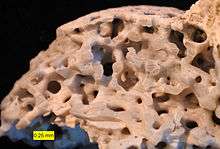Entobia

Entobia in a modern bivalve. Note the characteristic chambers connected by short canals.
Entobia and encrusters on a modern bivalve shell, North Carolina.
Entobia is a trace fossil in a hard substrate (typically a shell, rock or hardground made of calcium carbonate) formed by clionaid sponges as a branching network of galleries, often with regular enlargements termed chambers. Apertural canals connect the outer surface of the substrate to the chambers and galleries so the sponge can channel water through its tissues for filter feeding (Bromley, 1970). The fossil ranges from the Devonian to the Recent (Taylor and Wilson, 2003; Tapanila, 2006).
References
- Bromley, R.G. (1970). "Borings as trace fossils and Entobia cretacea Portlock, as an example". Geological Journal, Special Issue. 3: 49–90.
- Tapanila, L. (2006). "Devonian Entobia borings from Nevada, with a revision of Topsentopsis". Journal of Paleontology. 80: 760–767. doi:10.1666/0022-3360(2006)80[760:DEBFNW]2.0.CO;2.
- Taylor, P.D., Wilson. M.A. (2003). "Palaeoecology and evolution of marine hard substrate communities". Earth-Science Reviews. 62: 1–103. doi:10.1016/S0012-8252(02)00131-9.
External links
Entobia from the Prairie Bluff Chalk Formation (Maastrichtian, Upper Cretaceous) of Starkville, Mississippi. Preserved as a cast of the excavations.
This article is issued from Wikipedia - version of the 4/13/2016. The text is available under the Creative Commons Attribution/Share Alike but additional terms may apply for the media files.